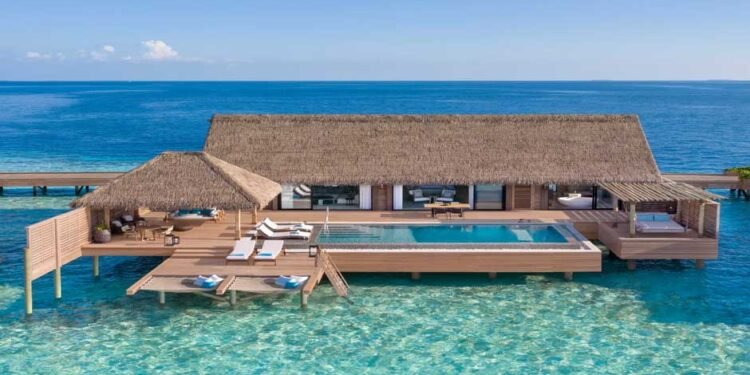Water bungalows, also known as overwater bungalows, are a quintessential icon of tropical luxury vacations, offering guests unparalleled access to the beauty of pristine waters right from their doorstep. Originating in the South Pacific and famously associated with exotic destinations like the Maldives and Bora Bora, these unique accommodations provide a blend of seclusion, romance, and connection with nature. Here’s everything you need to know about water bungalows.
1. Architecture and Design
Water bungalows are typically constructed on stilts directly over shallow lagoons or coral reefs. The architecture is designed to blend seamlessly with the natural environment, often featuring traditional materials and styles that reflect the local culture. The roofs are usually made of thatch or other natural materials, while the interiors tend to emphasize open, airy spaces with large glass doors and windows to maximize views of the ocean.
Inside, these bungalows are equipped with all the comforts of a luxury hotel room, including high-end furnishings, plush bedding, modern bathrooms, and often sophisticated technology. Many feature glass floor panels, known as “Tahitian television,” allowing guests to view the marine life swimming below without leaving their room.
2.Exclusive and Private
One of the biggest draws of water bungalows is their exclusivity and privacy. These units are often spaced apart from each other to provide a sense of isolation. This setup is ideal for honeymooners or anyone seeking a quiet and intimate getaway. The secluded decks offer private access to the water below, where you can swim, snorkel, or simply relax with minimal disturbances.
3. Location and Accessibility
Water bungalows are predominantly found in tropical regions, with the largest concentrations in Maldives resorts, French Polynesia, Fiji, and parts of Southeast Asia like Malaysia and the Philippines. Access to these bungalows is typically via boardwalks from the main resort areas, and some are even accessible only by boat, adding to their allure and sense of adventure.
4. Cost and Considerations
Staying in a water bungalow can be quite expensive due to its unique location and the luxurious amenities it offers. Prices vary widely depending on the destination, the time of year, and the level of luxury provided. It’s important to plan and book in advance, especially during peak tourist seasons, to secure a spot in these sought-after accommodations.
5. Environmental Impact
The construction and operation of water bungalows raise important environmental considerations. The best resorts implement sustainable practices to minimize impacts, such as constructing above the waterline to avoid damaging the marine ecosystem, using eco-friendly materials, and incorporating systems for water conservation and waste treatment. As a traveler, it’s worth researching and choosing resorts that are committed to environmental stewardship.
6. Activities and Amenities
Staying in a water bungalow often comes with access to a variety of water-based activities. Snorkeling, diving, paddleboarding, and canoeing are common, with equipment usually available for rent or included in the stay. Many bungalows also come with additional amenities like private infinity pools, outdoor showers, and personalized services such as in-room dining and spa treatments.
Conclusion
Water bungalows offer a unique and memorable experience, ideal for those looking to indulge in the ultimate tropical getaway. They provide not just luxurious accommodations but a direct connection to the ocean and a private slice of paradise. Whether for a honeymoon, a special anniversary, or a once-in-a-lifetime vacation, a stay in a water bungalow is sure to be an unforgettable highlight.












